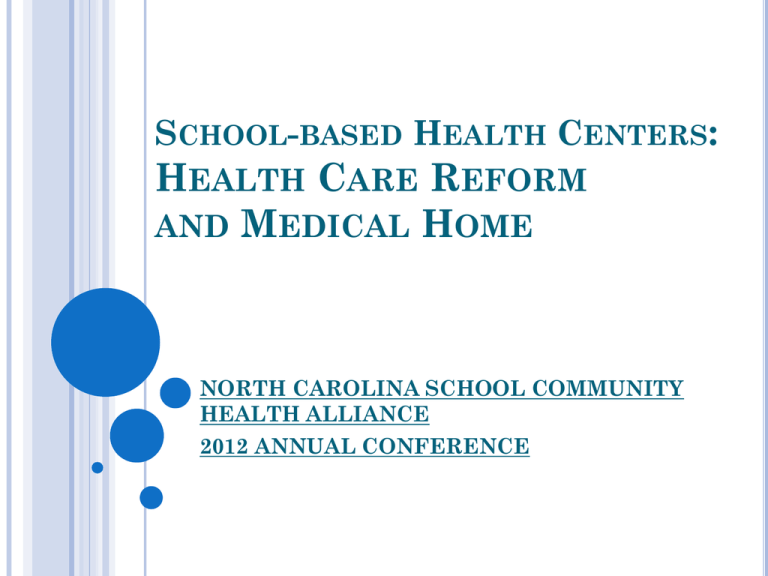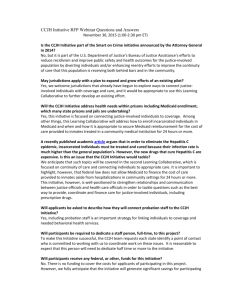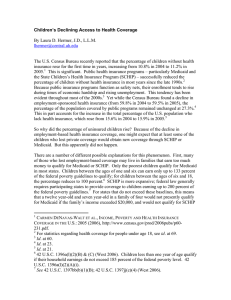School-based Health Centers: Health Care Reform and Medical Home
advertisement

SCHOOL-BASED HEALTH CENTERS: HEALTH CARE REFORM AND MEDICAL HOME NORTH CAROLINA SCHOOL COMMUNITY HEALTH ALLIANCE 2012 ANNUAL CONFERENCE OBJECTIVES Review health care reform initiatives that are relevant to school health Discuss background information concerning Medicaid and CHIP Examine medical home options for school-based health centers REFLECTIONS Shortage/maldistribution of primary care physicians Shortage of pediatricians who choose to enter community pediatrics The growth of ACO (Accountable Care Organization)-type entities Failure of school-based health centers to generate sufficient revenue to justify their existence PEDIATRICS 2020 AND BEYOND Sick children sicker Mental health issues Families more isolated Increased diversity Transitional care HEALTH EQUITY 17% of children live in poverty Poverty affects sequential generations of the same families Poverty status is a key contributor to poor health Generational violence robs lives Incarcerated youth share a common history Cabinet-level attention is needed What insurance reforms are included in the new law? Requires that private insurance include the following consumer protections: No annual caps on coverage No rescissions (if a child or adult gets sick, coverage can’t be lost) Children may stay covered on their parents’ policy until age 26 Children may not be denied care because of a pre-existing condition Minimum medical loss ratios Cap on out of pocket costs for families PREVENTABLE CAUSES OF DEATH IN N.C. Preventable Causes of Death in North Carolina (2007) Tobacco Use 13,720 Diet/Physical Inactivity 12,583 2,653 Alcohol Consumption 2,350 Microbial Agents Toxic Agents 1,743 Medical Error 1,516 Motor Vehicles 1,364 Firearms 910 Uninsurance 758 Unsafe Sex 606 Illicit Drug Use 531 0 2,000 4,000 6,000 8,000 10,000 12,000 14,000 16,000 Estimated Number of deaths State Center for Health Statistics, North Carolina Department of Health and Human Services, (2007). WHAT IS A MEDICAL HOME? An approach to providing health care services in a high-quality, comprehensive, and cost-effective manner Provision of care through a primary care physician through partnership with other allied health care professionals and the family Acts in best interest of children and youth to achieve maximum family potential Many notions tested among children and youth with special health care needs – but principles and characteristics apply broadly to all children/families MEDICAL HOME DEFINITION Primary care Family-centered partnership Community-based, interdisciplinary approach to care Care that is: accessible, family-centered, coordinated, compassionate, continuous, and culturally effective. Preventive, acute and chronic care Quality improvement ATTRIBUTES OF THE MEDICAL HOME Accessible Family Centered Continuous Comprehensive Coordinated Compassionate Culturally Competent NCQA: PATIENT CENTERED MEDICAL HOME MEASUREMENT Access and Communication Patient tracking and registries Care management Patient self management Electronic prescribing Test tracking Referral tracking Performance reporting and improving Enhanced electronic communications MEDICAL HOME Pediatric Medical Home under CCNC (Community Care of NC) Typical adult medicine medical home Information technology and the NC Health Information Exchange School-based health centers and medical home Health Care Reform CHIPRA (Children’s Health Insurance Program Reauthorization Act) ARRA (American Recovery and Reinvestment Act) HITECH Act Affordable Care Act (ACA) MEDICAID AND SCHIP 200 6 to 19 Years 100 200 1 to 6 Years 133 200 Birth to 1 Year 185 0 50 SCHIP 100 150 Medicaid 200 250 MEDICAID EXPANSION (2014) For patients younger than 65 who are not pregnant and have family incomes up to 133% of poverty 2014-2016: 100% federal funding After 2020: 90% federal funding Essential Health Benefits Package Eligible adults required to enroll their children in Medicaid/CHIP CHIPRA COMPONENTS $32.8 billion over 4.5 years 300% FPL eligibility for CHIP match $225m for quality and health IT $100m for outreach and enrollment 8 enrollment improvements – if state chooses 5, boosts federal funding Public/private partnership on premium subsidy – eliminates crowd out CHIPRA Strengthens AAP Access, Quality and Finance Pillars Establishes Medicaid and CHIP Payment and Access Commission Calls for development of a core set of health care quality measures for children enrolled in Medicaid or CHIP Directs implementation of a GAO study and report on access to primary and specialty services. CHIPRA COMPONENTS Immigrant Children's Health Improvement Act (ICHIA) – states can remove 5-year wait for legal immigrants Translation Services now at 75% FMAP Coverage of pregnant women up to 200% Dental benefits required Mental health parity, if provide mental health DAVID T. TAYLOE, JR., MD, FAAP 2706 Medical Office Place Goldsboro, NC 27534 919-734-4736 919-580-1017 (fax) dtayloe@aap.org December 4, 2012 FIRST DOLLAR COVERAGE FOR PREVENTIVE SERVICES September 23, 2010 Bright Futures: Guidelines for Health Supervision of Infants, Children, and Adolescents (AAP, MCHB) Does not apply to “grandfathered” plans Does not apply to Medicaid plans HEALTH CARE HOMES Grants available to state Medicaid programs as of January 1, 2011 Enrollees must have: 2 chronic conditions 1 chronic condition and at-risk for second 1 serious mental health condition CENTER FOR MEDICARE AND MEDICAID INNOVATION (CMI) Fiscal Year 2011-2019 $5 million available to organizations for design of projects $10 billion available for implementation of projects Project design/regulations pending GRANDFATHERED PLANS Existing group health plans or health insurance coverage in which a person was enrolled as of March 23, 2010 Prohibition on Pre-existing Conditions for Children, September 23, 2010 Prohibition on Pre-existing Conditions for Adults, January 1, 2014 Coverage of and Prohibition on Copayments and Deductibles for Preventive Care, September 23, 2010 PREVENTION AND PUBLIC HEALTH FUND $15 billion: FY 2010-2020 The fund will support programs authorized by the Public Health Service Act for prevention, wellness, and public health activities, including prevention research and health screenings and initiatives. www.hhs.gov/news/press/2010pres/06/20100618g. html PREVENTION AND PUBLIC HEALTH FUND $250 million: community-based health settings; obesity prevention and fitness; tobacco cessation; infectious disease outbreaks; CDC’s Clinical Preventive Services Task Force recommendations; public health workforce and training centers $250 million: US primary care workforce projects (residency slots; PA’s; NP’s;nurses) SCHOOL-BASED HEALTH CENTERS (SBHC’S) $200 million for FY 2010-2013 Target SBHC’s that serve large numbers of children eligible for Medicaid and CHIP Infrastructure only (not for paying for personnel or services) IMMUNIZATION COVERAGE IMPROVEMENT PROGRAM FY 2010-2014 Grants to states to improve the provision of recommended immunizations to children, adolescents, and adults Permanently reauthorizes the state immunization grant program in section 317(j) of the Public Health Service Act COMMUNITY TRANSFORMATION GRANTS FY 2010-2014 Funds for the implementation, evaluation, and dissemination of evidence-based community preventive health activities to reduce chronic disease rates, prevent the development of secondary conditions, address health disparities, and develop a stronger evidence base of effective prevention programming. PERSONAL RESPONSIBILITY EDUCATION FY 2010-2014 Grants to states for programs to educate adolescents on both abstinence and contraception and sexually transmitted infections, including HIV/AIDS AMERICAN RECOVERY AND REINVESTMENT ACT (ARRA) $87b in FMAP increase Hold enrollment at 7-1-08 levels Prompt payment 6.2% minimum increase $19b in Health IT infrastructure (2011) (HITECH Act, Title IV) 20% Medicaid patient threshold State planning and implementation grants ARRA $10.4 billion to NIH $1 billion for Prevention and Wellness Fund $500 million to HRSA workforce development $200 million for Title VII and VIII programs $300 million for the National Health Service Corps $2 billion for Child Care Development Block Grant PEDIATRIC ACCOUNTABLE CARE ORGANIZATION (ACO) Incentive payments to stimulate improvements in quality and cost-effectiveness Fee-for-service to providers who contract directly with payers Quality improvement payments to the ACO January 1, 2012 – December 31, 2016 AAP RESOURCE State Implementation of the Patient Protection and Affordable Care Act (ACA) www.aap.org/moc and go to “Advocacy” (lower left hand corner), and then “State Government Affairs,” then look for the document “State Health – State Implementation of the Patient Protection and Affordable Care Act (ACA)” FEDERAL ACA WEB PORTAL www.hhs.gov/ociio/regulations/webportal/index/ht ml www.healthcare.gov





